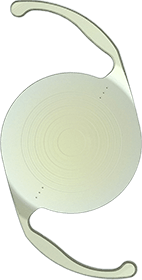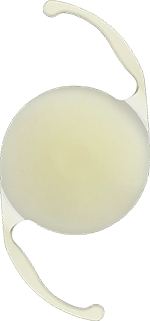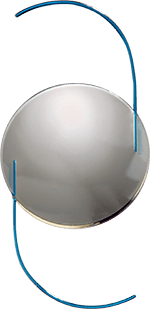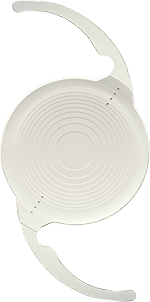Monofocal, Multifocal & Accommodative Lenses
Following removal of the eye’s natural crystalline lens during either cataract or Refractive Lens Exchange surgery, we have the option of implanting a variety of intraocular lenses. These lenses include the single vision monofocal lens (standard and aspheric models), monofocal Toric astigmatism correcting lenses, Multifocal lenses lenses (Panoptix, ReSTOR ActiveFocus, and TECNIS Multifocal lenses), Extended Depth of Focus lenses (Symfony and Symfony Toric lenses), and the accommodative Crystalens. Any of the lenses we use can be implanted through a self-sealing (usually without stitches) opening of less than 2.4 mm (varies somewhat based on lens design).
One commonly used lens for patients who would like the opportunity to see without glasses following their cataract or refractive lens exchange procedure is the standard single-focus monofocal lens implant which gives the surgeon the opportunity to correct the patient for either distance vision in both eyes or for monovision — also known as “blended vision”.
If both eyes are corrected for the clearest possible distance vision, cataract and Refractive Lens Exchange patients will most likely need reading glasses for most near tasks. With monovision, the surgeon corrects your dominant eye for seeing at distance and your non-dominant eye for near vision, thereby reducing the need for reading glasses. When both eyes are functioning together, the brain naturally selects the image from the eye that has a clearer focus.
Having eyes for different purposes might sound unsettling, but many patients do very well with monovision. Blended vision simply refers to monovision with a smaller discrepancy between the eyes. Many contact lens wearing patients over the age of 40 have tried monovision as a tool for reducing their need for reading glasses.
Monovision and blended vision are common techniques for patients over the age of 40, whether they are having laser vision correction (i.e., LASIK or PRK), or an implantable lens procedure (i.e., ICL, cataract, or Refractive Lens Exchange surgery). This allows patients to achieve good functional vision at both distances and near without the need for glasses or contact lenses.
Often patients desire having their eyes corrected to a similar level of vision. “I’d rather have both eyes the same,” they may say. To achieve that goal, multifocal IOLs can be implanted at the time of cataract or Refractive Lens Exchange surgery in order to allow each eye to see at both distance and near without glasses. The first multifocal IOL was approved by the FDA in 1997. While this lens did enable patients to see at both distance and near without glasses, visual side effects were too frequent for the lens to be used frequently. Fortunately, multifocal IOL technology has improved markedly since 1997, with later generation IOLs being able to provide patients with a reliable range of clear vision with a minimum risk of undesirable side effects. Dr. Davidorf has been on the forefront of multifocal and accommodative lens technology (research/clinical trials/clinical practice) for over 20 years, striving to provide patients with robust, high quality vision without glasses. A brief review of the most commonly used multifocal and accommodative lenses used today follows.

The PanOptix Trifocal IOL
The PanOptix Trifocal IOL also known is designed to enable patients to see as much as possible without glasses. As its name implies, the PanOptix Trifocal lens has three different focal points that allow light rays from images at three different distances to focus clearly onto the back of the eye (retina). The PanOptix lens allows for good distance vision (ie: driving and television watching), intermediate vision (ie: computer and conversation), and near vision (ie: reading). This lens allows for clear vision once the eye’s natural lens has been removed (the first step of (cataract or Refractive Lens Exchange surgery).
Upon its approval by the FDA in September, 2019, Dr. Jonathan Davidorf became one of the very first surgeons in the U.S. to implant the newly FDA approved PanOptix Trifocal lens. The PanOptix lens is still the only FDA approved trifocal lens available. Patients have reported better image quality with the PanOptix over other leading multifocals. Most patients experience enhanced close and middle vision and easier reading without the need for reading glasses. In a clinical study, 129 patients were asked about their experience with the PanOptix Lenses, and 99% of those people with the PanOptix lens confirmed they would choose the same lens again. In that same study, 98% of patients claimed they would recommend it to family and friends.
According to Dr. Davidorf, “We have some excellent Bifocal and Extended Depth of Focus lens implants, but the PanOptix lens is the first Trifocal lens available in the U.S. It’s not like progressive glasses or bifocals, where you have to look up to see distance and down to see near. With this lens design you can look in any direction of gaze to see distance, intermediate, or near.”
The PanOptix Lens filters ultraviolet light and also comes in a blue light blocking model, aiding in the protection of eyes from screens and sunlight. It is available in both astigmatism correcting and non-astigmatism correcting models.

Vivity Extended Vision IOL
Vivity Extended Vision IOL (DFTx15, DATx15): Extended depth of focus lens for seeing far, intermediate, and near. The near vision is not as strong as with a true multifocal lens, but the Vivity approaches a monofocal lens in terms of the contrast sensitivity, clarity and minimum of side effects it provides. Some patients who are not ideal candidates for a multifocal lens may still qualify as Vivity candidates. It is available in clear and blue-blocker, toric and non-toric versions.

Toric Lens
Contact lens wearers are often familiar with the word “toric.” In optics, toric refers to a lens that is steeper in one direction and flatter in another, enabling the correction of astigmatism. Similar to contact lenses, intraocular lenses implanted at the time of cataract or refractive lens exchange surgery can be either non-toric or toric. Properly oriented, toric lenses allow patients with astigmatism to see without glasses. Toric lenses can be monofocal (single focus), multifocal (ie: PanOptix Toric Trifocal Lens, ReSTOR Toric Lens with ActiveFocus), Extended Depth of Focus (ie: Symfony Toric), or Accomodating (ie: Crystalens Trulign Toric). Each patient’s goals for spectacle independence combined with the characteristics of their eyes will help determine which lens is best suited for their situation.
Toric lenses are not merely about spectacle independence, however. Particularly for patients with moderate to higher levels of astigmatism, the use of a toric lens implant allows patients to see without some of the distorting effects of high-astigmatism correcting glasses. Glasses prescriptions for patients with higher prescriptions – especially higher astigmatism prescriptions – have a much less forgiving “sweet spot” compared with easier to tolerate lower prescription glasses. When the glasses shift on one’s face, or a person’s gaze changes from up to down or from left to right, it seems to the patient as if they’re looking through someone else’s glasses. The vision is no longer clear. Instead, correcting one’s astigmatism inside the eye – with a toric lens implant (as opposed to in front of the face with spectacles) – can obviate the need for these types of glasses. Once the eye heals, toric lens implants stay in position so that one’s vision clarity is not gaze dependent like it is with astigmatism correcting glasses. In other words, even for patients who really don’t care whether or not they wear glasses after their cataract surgery, a toric lens implant may still be a very reasonable – and often preferable – consideration.

Light Adjustable Lens (LAL)
Since the year 2000, Dr. Davidorf has been featuring an exciting technology – the Light Adjustable Lens – in his Course, “New and Emerging Technologies in Cataract and Refractive Surgery.” Finally, in November of 2017, the Light Adjustable Lens received approval by the FDA. As with other lens implants, the Light Adjustable Lens (LAL) is implanted at the time of cataract or Refractive Len Exchange surgery. However, with the LAL, the power of the implant can be adjusted after it is implanted. A special light source is used to accomplish the “power adjustment.” Once the patient is satisfied with their lens power, the patient undergoes a third procedure in order to “lock-in” (finalize) the lens power. Once the lock-in occurs, the lens power remains stable and cannot be subsequently altered. As with other lens implants, the LAL can correct nearsightedness, farsightedness, and astigmatism. It is not available in a multifocal design.
For most patients – because of considerations of the quality of lens optics, lens materials, and the accuracy of current lens implant power calculations – the LAL is not the preferred choice. However, for patients with unusually shaped eyes and unreliable lens power calculations, the LAL can be a very good option. Currently, companies are working on developing lenses that can be continually adjusted throughout one’s lifetime. Stay tuned!

Symfony Lens
The Symfony lens is the first lens to be approved by the FDA with the designation “extended range of focus” intraocular lens. While the lens implant looks like a multifocal lens, the optics work differently. Instead of producing two distinct focal points, the lens can achieve excellent clarity at distance and a range of clear vision at near for patients receiving the lens.
The arrival of the Symfony lens has been welcomed news because many patients who were not good candidates for a multifocal lens can, in fact, be very good Symfony candidates. The Symfony Lens is available in both astigmatism correcting (toric) and non-astigmatism correcting models.ony lens is the first lens to be approved by the FDA with the designation “extended range of focus” intraocular lens. While the lens implant looks like a multifocal lens, the optics work differently. Instead of producing two distinct focal points, the lens can achieve excellent clarity at distance and a range of clear vision at near for patients receiving the lens.
Our expectations for Symfony patients are that they should be able to pass a driver’s test, navigate their cell phone, perform most computer tasks, and read their Kindle without the need for glasses. A multifocal lens can be considered a bit stronger than the Symfony with regards to its ability to provide newspaper or paperback book reading vision to implanted patients. While complete spectacle independence is often our goal with our refractive cataract surgery patients, we are, of course, unable to guarantee any specific outcome. Like multifocal lens patients, patients undergoing Symfony lens implantation need to understand that they may see some halos/rings around lights when driving at night. Fortunately, the incidence of persistent and troublesome night vision disturbances is uncommon.
Patients contemplating cataract or refractive lens exchange surgery can be evaluated for their candidacy for the Symfony lens or other refractive techniques during an in-office consultation.

Tecnis Multifocal Lens
The Tecnis Multifocal Lens is a bifocal intraocular lens that can allow most patients to see without glasses for distance, intermediate, and near vision tasks following their cataract or refractive lens exchange surgery. Earlier multifocal lenses had some challenges providing a reasonable level of near vision under suboptimal lighting conditions. The Tecnis Multifocal Lens changed the paradigm in its ability to predictably achieve good functional near vision under most reasonable lighting conditions. The Tecnis Multifocal Lens is available in three different reading powers. As with other multifocal lenses, the vision results with the Tecnis Multifocal Lens occur quickly. Within a few days, patients usually already begin to utilize both their distance and near vision. Once healed, over 90% of our Tecnis Multifocal Patients report rarely (if ever) wearing glasses after their procedure. While it’s common for patients to see halos around lights at night for a period of time with most multifocal lens implants, these symptoms typically abate over the ensuing few weeks. Occasionally, halo symptoms endure after a few months. Deciding which specific lens to implant depends, of course, on an individual’s lifestyle, personal preferences and overall health of the eyes. The first step is to schedule an eye exam to determine the best options for vision correction.

AcrySof® IQ ReSTOR® IOL with ACTIVEFOCUS:
Potentially Eliminate Cataracts and the Need For Glasses All at Once
The original AcrySof® ReSTOR® lens wasis a breakthrough multifocal intraocular lens (IOL when it gained FDA approval in 2005. The initial ReSTOR® lens had a near focal point that was quite close, which made computer vision a bit difficult. While it was a high quality lens, subsequent design modifications improved its functionality. The final iteration of the ReSTOR® IOL is the AcrySof® ReSTOR® IOL with ACTIVEFOCUS. This lens is more distance dominant compared with earlier ReSTOR IOls, with a near focal point at approximately arm’s length. This allows patients excellent driving vision with a minimum of potential side effects, while still enabling patients to see the dashboard, see a text message (not while driving, please!), or check emails without the need for glasses. For more detailed near vision tasks (reading, lengthy computer work), ACTIVEFOCUS patients still often need reading glasses. For patients who want multifocal technology that maximizes their near vision without glasses, the PanOptix IOL tends to be a better option.
The AcrySof® IQ ReSTOR® IOL with ACTIVEFOCUS filters ultraviolet light and also comes in a blue light blocking model. Similar to PanOptix, it is available in both astigmatism correcting and non-astigmatism correcting models.

Crystalens
Originally approved by the FDA in 2003, the Crystalens can effectively treat cataracts and presbyopia (loss of reading vision) by replacing the eye’s natural lens with an accommodating lens.
This lens is designed with tiny hinges that allow the implant to move forward and backward, accommodating in response to the eye’s focusing muscles. It is designed to mimic the natural human lens. The Crystalens provides an increased depth of focus to allow patients to see objects at all distances, reducing or eliminating a their need for glasses.
The amount of accommodation that the Crystalens provides varies somewhat from patient to patient. Some patients may still need the aid of reading glasses to read smaller print or when reading in dim light. In order to add extra strength to patients’ ability to read without glasses, Crystalens implantation is frequently combined with mild monovision. The Crystalens is available in both astigmatism correcting (Trulign Toric) and non-astigmatism correcting models.



